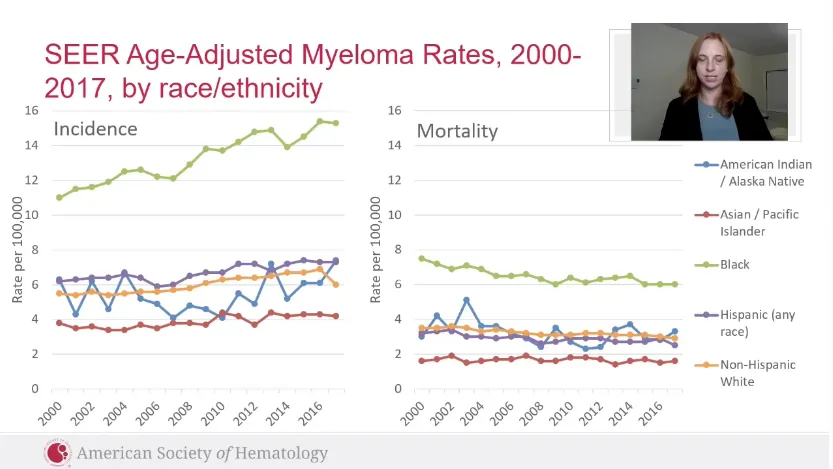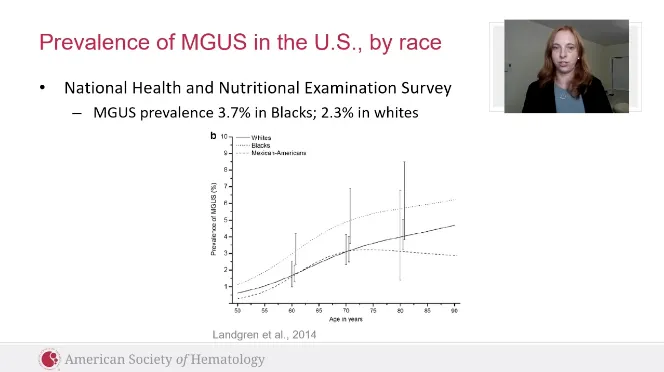ASH 2020: MGUS in Black Multiple Myeloma Patients

What risk factors affect the progression of MGUS to active myeloma in the African American population? Kimberly A. Bertrand, ScD from Boston University concluded at the recent ASH 2020 meeting that we don't have enough data to come to definitive conclusions. She discusses studies reviewing genetics, obesity, income and education levels have not been conclusive in determining why there are such significant disparities in prevalence and in outcomes.
The Disparities in Occurrence and Outcomes are Real
In the SEER chart below, it's clear that African American patients are 2-3 times more likely to develop multiple myeloma than their white counterparts. They also have higher death rates compared to other ethnic communities. The pressing question remains - what is causing the higher death rate?

MGUS by Ethnicity
We also know that MGUS is precursor condition for all myeloma patients and find a similarly high occurrence for MGUS in black patients in addition to multiple myeloma.

Potential Factors Causing Disparities in Outcomes
Several studies have reviewed potential factors that could be causing the disparities in outcomes. Are the reasons genetic, environmental, family history, related to other diseases, relevant to the immune system or based on socioeconomic factors?
Geography
In prior studies, it has been shown that both African Americans and black patients from Ghana, Africa exhibit similar incidence levels of multiple myeloma (2-3 times whites). Dr. Bertrand also referred to a study by Ola Landgren, MD, PhD from 2014 showing that there seemed to be more myeloma occurrence in the North and Midwest (3.1%) compared to the South and West (2.1%). It is unknown what caused this difference and if it could be occupational, environmental or ethnic makeup of those geographies.
Socioeconomic Factors
Socioeconomic factors such as lower educational levels or lower household income can affect how cancer patients are treated. However, a 2000 Southern states study by Dr. Baris showed that low education or low household income didn't make a difference in survival when black and white MGUS female patients were compared.
Lifestyle
Obesity is a known condition to increase the progression from MGUS to active myeloma. Obesity is a risk of progression for all myeloma patients. There is an 80% increased risk of MGUS if patients have a Body Mass Index (BMI) over 30 kg/m2. When obese white and black patients were compared, their survival was similar, indicating that obesity alone is not a differentiating factor. The increased prevalence of diabetes in the black community carrying twice the incidence may show disparity in multiple myeloma and is an emerging risk factor.
Genetic Factors
There are 24 known genetic risk variants for multiple myeloma and MGUS patients. Researchers wanted to know if the black community had common myeloma genetic factors that could be more aligned. However, a recent study showed that the most common genetic occurrences were relatively consistent for white and black patients alike, ruling out the idea that genetics alone were the cause of the differences in outcomes.

Immune System Differences
Dr. Bertrand noted that patient response to therapy can differ by race - how our B-cells activate and how our immune system profile fends off growing myeloma. Black patients could have higher levels of pro-inflammatory cytokines or there could be additional immune responses that are different. This is an unstudied area.
Additional B-Cell stimulating factors including infections, autoimmune and inflammatory diseases could be related, but in a National Health and Nutrition Examination Survey study, the black and white population data was similar.
Conclusions from this study indicate genetics do not play a role in racial disparity for MGUS and myeloma and that there is a need for large population-based studies in African Americans to specifically identify modifiable risk factors. Clearly, more study on this topic is sorely needed.
What risk factors affect the progression of MGUS to active myeloma in the African American population? Kimberly A. Bertrand, ScD from Boston University concluded at the recent ASH 2020 meeting that we don't have enough data to come to definitive conclusions. She discusses studies reviewing genetics, obesity, income and education levels have not been conclusive in determining why there are such significant disparities in prevalence and in outcomes.
The Disparities in Occurrence and Outcomes are Real
In the SEER chart below, it's clear that African American patients are 2-3 times more likely to develop multiple myeloma than their white counterparts. They also have higher death rates compared to other ethnic communities. The pressing question remains - what is causing the higher death rate?

MGUS by Ethnicity
We also know that MGUS is precursor condition for all myeloma patients and find a similarly high occurrence for MGUS in black patients in addition to multiple myeloma.

Potential Factors Causing Disparities in Outcomes
Several studies have reviewed potential factors that could be causing the disparities in outcomes. Are the reasons genetic, environmental, family history, related to other diseases, relevant to the immune system or based on socioeconomic factors?
Geography
In prior studies, it has been shown that both African Americans and black patients from Ghana, Africa exhibit similar incidence levels of multiple myeloma (2-3 times whites). Dr. Bertrand also referred to a study by Ola Landgren, MD, PhD from 2014 showing that there seemed to be more myeloma occurrence in the North and Midwest (3.1%) compared to the South and West (2.1%). It is unknown what caused this difference and if it could be occupational, environmental or ethnic makeup of those geographies.
Socioeconomic Factors
Socioeconomic factors such as lower educational levels or lower household income can affect how cancer patients are treated. However, a 2000 Southern states study by Dr. Baris showed that low education or low household income didn't make a difference in survival when black and white MGUS female patients were compared.
Lifestyle
Obesity is a known condition to increase the progression from MGUS to active myeloma. Obesity is a risk of progression for all myeloma patients. There is an 80% increased risk of MGUS if patients have a Body Mass Index (BMI) over 30 kg/m2. When obese white and black patients were compared, their survival was similar, indicating that obesity alone is not a differentiating factor. The increased prevalence of diabetes in the black community carrying twice the incidence may show disparity in multiple myeloma and is an emerging risk factor.
Genetic Factors
There are 24 known genetic risk variants for multiple myeloma and MGUS patients. Researchers wanted to know if the black community had common myeloma genetic factors that could be more aligned. However, a recent study showed that the most common genetic occurrences were relatively consistent for white and black patients alike, ruling out the idea that genetics alone were the cause of the differences in outcomes.

Immune System Differences
Dr. Bertrand noted that patient response to therapy can differ by race - how our B-cells activate and how our immune system profile fends off growing myeloma. Black patients could have higher levels of pro-inflammatory cytokines or there could be additional immune responses that are different. This is an unstudied area.
Additional B-Cell stimulating factors including infections, autoimmune and inflammatory diseases could be related, but in a National Health and Nutrition Examination Survey study, the black and white population data was similar.
Conclusions from this study indicate genetics do not play a role in racial disparity for MGUS and myeloma and that there is a need for large population-based studies in African Americans to specifically identify modifiable risk factors. Clearly, more study on this topic is sorely needed.

about the author
Diahanna Vallentine
Diahanna is the Financial Program Manager for the HealthTree Foundation, specializing in financial help for multiple myeloma and AML patients. As a professional financial consultant and former caregiver of her husband who was diagnosed with multiple myeloma, Diahanna perfectly understands the financial issues facing myeloma patients.
More on Conferences
Trending Articles
Upcoming Events




Get the Latest Multiple Myeloma Updates, Delivered to You.
By subscribing to the HealthTree newsletter, you'll receive the latest research, treatment updates, and expert insights to help you navigate your health.
Together we care.
Together we cure.
3x Faster.












